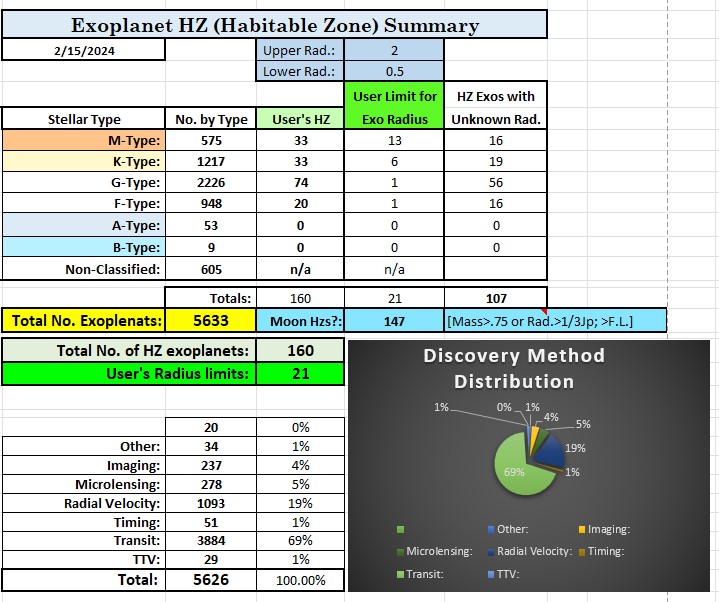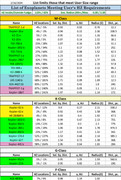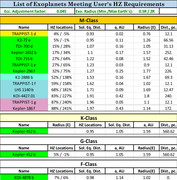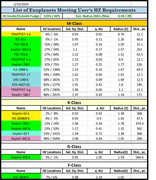Exoplanet Stats
Page 6 - Seeking answers about space? Join the Space community: the premier source of space exploration, innovation, and astronomy news, chronicling (and celebrating) humanity's ongoing expansion across the final frontier.
You are using an out of date browser. It may not display this or other websites correctly.
You should upgrade or use an alternative browser.
You should upgrade or use an alternative browser.
5,500 exoplanets is today's count!
Here is the Kopparapu, et. al., HZ result, which is a more complex model that uses atmospheric qualifications for a HZ. Their model also uses a broader planet size range.
If we compare the following to the other methods (prior post) that restrict the probable habitable sizes to 0.5 to 1.8x Earth, then there are only three exos on this list that qualify (#28, 32, 33).
View: https://imgur.com/pAnS58v
Here is the Kopparapu, et. al., HZ result, which is a more complex model that uses atmospheric qualifications for a HZ. Their model also uses a broader planet size range.
If we compare the following to the other methods (prior post) that restrict the probable habitable sizes to 0.5 to 1.8x Earth, then there are only three exos on this list that qualify (#28, 32, 33).
View: https://imgur.com/pAnS58v
We know that habitable exoplanets' geo-biophysical statistics are important for us to accurately pinpoint that they are really habitable, and thus, we are going to inhabit them as Nature planned.
The exoplanet count is essentially unchanged. It went to about 5510, but oddly, dropped to its current number of 5506.
These are confirmed exos, out of perhaps > 10,000. Science is a constant scrutiny process, so some ups and downs in numbers.
These are confirmed exos, out of perhaps > 10,000. Science is a constant scrutiny process, so some ups and downs in numbers.
Ug. Looks like I'm either doing something wrong with Imgur links or they are.
Both this and the next post show a run where the HZ is fudged by 10% in both directions. There are "optimistic" extensions of the HZ used that are far greater to cover a number of possibilities.
Let me try Postimages work....

Both this and the next post show a run where the HZ is fudged by 10% in both directions. There are "optimistic" extensions of the HZ used that are far greater to cover a number of possibilities.
Let me try Postimages work....

An update is overdue, I suppose.
There are now many new features and tweaks.
1) A paper provides a formula to determine how an exo will see increasing luminosity for increasing eccentricity, but with a cutoff of around 0.5 ecc. as such a fluctuation seems highly unfavorable for habitability, IMO. This is now included.
2) The Equilibrium Temp. formula was found to always have the same results as what I call the Temp. Method (simple luminosity equation for HZi and HZo). But, the Eq. Temp. method bumps the HZinner to 1.15x the TM (Temp Method) and 0.42x the TM for the HZouter. IOW, it is a broader HZ (Habitable Zone) than the TM method.
3) Given #2, the program allows the User to have their own luminosity change factors. I have used 1.15 and 0.42. This broader zone is more than suggested by the Kopparapu, et. al., method incorporating atmospheric adjustments.
4) However, both the normal Temp. Meth. result and the User Luminosity adjustment results are shown together (e.g. "78% / 110%). The first value (78%) is how deep the orbital radius is within the HZ, where 50% is in the middle. The second value (110%) reveals that it is 10% beyond the HZo using the TM (Temp. Method).
5) As just stated, the User adjusts luminosity, not distance. It is luminosity that best determines our current understand of HZs for exoplanets so far.
6) The Classical Method, which uses numerous variables like mag., stellar class, temp. and radius, distance, has fewer results and, given the weaker accuracy of these, more trouble than it's worth, IMO. This may change as the data improves, perhaps.
7) The entire list is sorted by their relative distance from the star by converting their actual orbits to what they would be if they were orbiting the Sun. This is the Solar Equivalent Radius result.
8) Having #7 allows us to see the exoplanets progress in temperature (luminosity) zones where the more red colors represent the hotter zones and the blue and violet highlights show them as being in colder regions, but still within the HZ. The bright green represents the TM range of values.
There's more but "nuff said.", as Tyrus might say.

 ibb.co
ibb.co
There are now many new features and tweaks.
1) A paper provides a formula to determine how an exo will see increasing luminosity for increasing eccentricity, but with a cutoff of around 0.5 ecc. as such a fluctuation seems highly unfavorable for habitability, IMO. This is now included.
2) The Equilibrium Temp. formula was found to always have the same results as what I call the Temp. Method (simple luminosity equation for HZi and HZo). But, the Eq. Temp. method bumps the HZinner to 1.15x the TM (Temp Method) and 0.42x the TM for the HZouter. IOW, it is a broader HZ (Habitable Zone) than the TM method.
3) Given #2, the program allows the User to have their own luminosity change factors. I have used 1.15 and 0.42. This broader zone is more than suggested by the Kopparapu, et. al., method incorporating atmospheric adjustments.
4) However, both the normal Temp. Meth. result and the User Luminosity adjustment results are shown together (e.g. "78% / 110%). The first value (78%) is how deep the orbital radius is within the HZ, where 50% is in the middle. The second value (110%) reveals that it is 10% beyond the HZo using the TM (Temp. Method).
5) As just stated, the User adjusts luminosity, not distance. It is luminosity that best determines our current understand of HZs for exoplanets so far.
6) The Classical Method, which uses numerous variables like mag., stellar class, temp. and radius, distance, has fewer results and, given the weaker accuracy of these, more trouble than it's worth, IMO. This may change as the data improves, perhaps.
7) The entire list is sorted by their relative distance from the star by converting their actual orbits to what they would be if they were orbiting the Sun. This is the Solar Equivalent Radius result.
8) Having #7 allows us to see the exoplanets progress in temperature (luminosity) zones where the more red colors represent the hotter zones and the blue and violet highlights show them as being in colder regions, but still within the HZ. The bright green represents the TM range of values.
There's more but "nuff said.", as Tyrus might say.

Summary-Feb-15th-2024-New-system hosted at ImgBB
Image Summary-Feb-15th-2024-New-system hosted in ImgBB
Last edited:
I'm doubtful any M-class planet will prove favorable over exos in any other class stellar system, assuming the same solar equivalent orbit. But, ignoring that, there are a couple of others that are near the middle of the HZ and are almost 10x farther from their likely active stellar host.Trappist system looks like the one to beat.
I think Kepler-62 f looks well placed. It may be a little in the cooler side of the HZ, but it has a 1.38 Re, so it likely has a healthy atmosphere to make up the difference. It's also farther away from the host, about that of Venus.
K2-18 b was outside the User's exo size limits, which was 2.0 radii.Where is K2-18 b? The subject of a variety of reports indicating JWST may have found life on it.
So, bumping this to 2.5R....

But, I'm not optimistic for any planet that orbits so close to its host, especially given that more and more we learn that M-class stars are found to be tantrum prone. Perhaps I've been around too many small (and fisty) dogs.
Last edited:
In this last run, there are 127 HZ exoplanets with unknown radii. I could check, but I'd bet up to about half of these have known masses.
I made a small effort to calculate the range of density for those with known values in hopes I could use their density range to calculate these unknown radii, but the density variation was up to two orders! Perhaps another could figure this out. It could potentially give us a nice bump to our number of ideal HZ exo list.
I made a small effort to calculate the range of density for those with known values in hopes I could use their density range to calculate these unknown radii, but the density variation was up to two orders! Perhaps another could figure this out. It could potentially give us a nice bump to our number of ideal HZ exo list.
Last edited:
Things won't get really interesting before we manage to build a +1km telescope in space to observe the potential megafauna of these worlds. It may have to have a diameter as large as 10km to actually identify signs of life, but with 3D printers it should be possible.
Here are more interesting facts found for 1500 exoplanets...
The mean (median) inclination angle is 88.24 degrees, where 90 degrees is dead on to the center of the star. The average inclination is 85.4 deg. The lowest value of inclination is 0.4 deg.
The mean semi maj. axis is only 0.53 AU.
The maximum orbital distance for a transit observation depends only on the inclination angle and the size of the star.
[Correcting this...The mean max. distance for the given inclinations and respective star sizes is....30.18 AU. Thus, surprisingly, less than 1/4% of the maximum orbital distance we can find them have we actually found exoplanets! It's my guess we are still in the low hanging fruit observational success so far. Of course, the greater orbits require years of observations to catch their transits.
Correction...These values involved a few false assumptions. I'll post the correct estimates soon .]
The mean (median) inclination angle is 88.24 degrees, where 90 degrees is dead on to the center of the star. The average inclination is 85.4 deg. The lowest value of inclination is 0.4 deg.
The mean semi maj. axis is only 0.53 AU.
The maximum orbital distance for a transit observation depends only on the inclination angle and the size of the star.
[Correcting this...The mean max. distance for the given inclinations and respective star sizes is....30.18 AU. Thus, surprisingly, less than 1/4% of the maximum orbital distance we can find them have we actually found exoplanets! It's my guess we are still in the low hanging fruit observational success so far. Of course, the greater orbits require years of observations to catch their transits.
Correction...These values involved a few false assumptions. I'll post the correct estimates soon .]
Last edited:
Ah, I realized that the inclination is not in reference to the star’s equator, but, to the Earth’s line of site. Naturally, a lower inclination would not allow for occultation, it would pass above or below.
I imagine that eccentricity would be limited, at very high eccentricities, allowing for a very high apoapsis, the periapsis would be close to the star as to be disruptive to the planet. Too much and it may reach the Roche limit of the star.
I imagine that eccentricity would be limited, at very high eccentricities, allowing for a very high apoapsis, the periapsis would be close to the star as to be disruptive to the planet. Too much and it may reach the Roche limit of the star.
Eccentricities will effect the transit inclinations over time due to precession. There are eccentricities stated for many exoplanets, but not that many.
I hope to finish coding what I need to show how much more distance is available to find more exoplanets in those orbital planes. I'm breaking it down by star class, which may reveal a difference, perhaps, between them.
I hope to finish coding what I need to show how much more distance is available to find more exoplanets in those orbital planes. I'm breaking it down by star class, which may reveal a difference, perhaps, between them.
Here is the revised version of what I was trying to say above.
I took average values and median values, but the number of outliers favors the median results.
This illustration shows that there isn't that often a maximum orbital distance that can be observed using the transit method that will exceed 1 AU (Earth's orbit). But there are ~ 40 star systems that do have greater than 1 AU distances available, if exoplanets are there.
The decreasing inclination angles, as shown, are the reason the larger stars don't allow [reveal so far] much of an increase.
Of course, thousand more observations and updates on existing data will, hopefully, improve things.
The max. available orbital distance is simply the radius of the star divided by the cosine of the inclination angle. MaxD = R/Cos(I).
To convert this to AU, divide by 215, which, *cough*, I forgot to do in the last post's report.
The median star sizes are scaled in the illustration. The semi major distances are scaled only with each other, not with the star's radii.
I was able to find 681 exoplanets having the necessary data to complete these. There were a few in the database that stated their semi maj. axis with a value having an inclination incompatible with the star's radius.
[Data courtesy of Exoplanet.eu]
BTW, I think I might be close on the star colors, too.

I took average values and median values, but the number of outliers favors the median results.
This illustration shows that there isn't that often a maximum orbital distance that can be observed using the transit method that will exceed 1 AU (Earth's orbit). But there are ~ 40 star systems that do have greater than 1 AU distances available, if exoplanets are there.
The decreasing inclination angles, as shown, are the reason the larger stars don't allow [reveal so far] much of an increase.
Of course, thousand more observations and updates on existing data will, hopefully, improve things.
The max. available orbital distance is simply the radius of the star divided by the cosine of the inclination angle. MaxD = R/Cos(I).
To convert this to AU, divide by 215, which, *cough*, I forgot to do in the last post's report.
The median star sizes are scaled in the illustration. The semi major distances are scaled only with each other, not with the star's radii.
I was able to find 681 exoplanets having the necessary data to complete these. There were a few in the database that stated their semi maj. axis with a value having an inclination incompatible with the star's radius.
[Data courtesy of Exoplanet.eu]
BTW, I think I might be close on the star colors, too.

Last edited:
The number of exos are increasing, albeit slowly at this point....
Also, I found a site that presents the range of densities for the three classes of planets (iron, silicate, water ice). [see graph in link]
Since many exoplanets have unknown radii but known mass, using this density data allows us to calculate the radius for each. Doing so bumps the Earthish (is this a better term?) HZ exoplanets by 40% in number. Here is the revised list:

Also, I found a site that presents the range of densities for the three classes of planets (iron, silicate, water ice). [see graph in link]
Since many exoplanets have unknown radii but known mass, using this density data allows us to calculate the radius for each. Doing so bumps the Earthish (is this a better term?) HZ exoplanets by 40% in number. Here is the revised list:

The latest count is now 43 exos that may be Earth-like. I found that the database includes stellar temperature host stars (low temp. M-class)much cooler than my program’s limit.
IMO, the M-class stars are far less likely to offer life on the listed HZ exos.
IMO, the M-class stars are far less likely to offer life on the listed HZ exos.
FWIW, Wiki also lists HZ exos. They seem to be using the equilibrium temp. method, which bumps the outer HZ by 54%. I am dubious of this method.
Similar threads
- Replies
- 1
- Views
- 11K
- Replies
- 134
- Views
- 41K
TRENDING THREADS
-
-
-
-
-
A Theory Suggesting Black Holes Don’t Just Swallow Matter, They Also Tear and Fling It Away – Looking for Feedback
- Started by adamator202
- Replies: 13

Space.com is part of Future plc, an international media group and leading digital publisher. Visit our corporate site.
© Future Publishing Limited Quay House, The Ambury, Bath BA1 1UA. All rights reserved. England and Wales company registration number 2008885.





